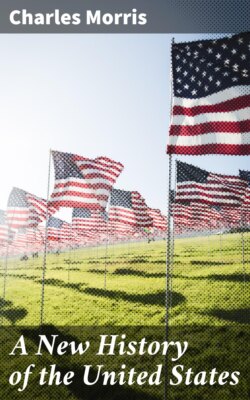Читать книгу A New History of the United States - Charles Morris - Страница 39
На сайте Литреса книга снята с продажи.
DISCOVERY AND EXPLORATION.
ОглавлениеTable of Contents
The Visits of the Northmen to the New World—The Indians and Mound Builders—Christopher Columbus—His Discovery of America—Amerigo Vespucci—John Cabot—Spanish Explorers—Balboa—His Discovery of the Pacific—Magellan—Ponce de Leon—De Narvaez—De Soto—Menendez—French Explorers—Verrazzani—Cartier—Ribault—Laudonnière—Champlain—La Salle—English Explorers—Sir Hugh Willoughby—Martin Frobisher—Sir Humphrey Gilbert—Sir Walter Raleigh—The Lost Colony—Dutch Explorer—Henry Hudson.
THE NORTHMEN.
Amerigo Vespucci
It has been established beyond question that the first white visitors to the New World were Northmen, as the inhabitants of Norway and Sweden were called. They were bold and hardy sailors, who ventured further out upon the unknown sea than any other people. It was about the year 1000 that Biorn, who was driven far from his course by a tempest, sighted the northern part of the continent. Other adventurers followed him and planted a few settlements, which, however, lasted but a few years. Snorri, son of one of these settlers, was the first child born of European parents on this side of the Atlantic. Soon all traces of these early discoverers vanished, and the New World lay slumbering in loneliness for nearly five hundred years.
THE MOUND BUILDERS.
Nevertheless, the country was peopled with savages, who lived by hunting and fishing and were scattered over the vast area from the Pacific to the Atlantic and from the Arctic zone to the southernmost point of South America. No one knows where these people came from; but it is probable that at a remote period they crossed Bering Strait, from Asia, which was the birthplace of man, and gradually spread over the continents to the south. There are found scattered over many parts of our country immense mounds of earth, which were the work of the Mound Builders. These people were long believed to have been a race that preceded the Indians, and were distinct from them, but the best authorities now agree that they were the Indians themselves, who constructed these enormous burial-places and were engaged in the work as late as the fifteenth century. It is strange that they attained a fair degree of civilization. They builded cities, wove cotton, labored in the fields, worked gold, silver, and copper, and formed regular governments, only to give way in time to the barbarism of their descendants, who, though a contrary impression prevails, are more numerous to-day than at the time of the discovery of America.
DISCOVERY OF AMERICA BY COLUMBUS.
MEETING BETWEEN THE NORTHMEN AND NATIVES.
The real discoverer of America was Christopher Columbus, an Italian, born in Genoa, about 1435. He was trained to the sea from early boyhood, and formed the belief, which nothing could shake, that the earth was round, and that by sailing westward a navigator would reach the coast of eastern Asia. The mistake of Columbus was in supposing the earth much smaller than it is, and of never suspecting that a continent lay between his home and Asia.
He was too poor to fit out an expedition himself, and the kings and rulers to whom he applied for help laughed him to scorn. He persevered for years, and finally King Ferdinand and Queen Isabella of Spain were won over to his views. They and some wealthy friends of Columbus furnished the needed funds, and on August 3, 1492, he sailed from Palos, Spain, in command of three small vessels, the Santa Maria, the Pinta, and the Nina.
As the voyage progressed, the sailors became terrified and several times were on the point of mutiny; but Columbus by threats and promises held them to their work, and on Friday, October 12, 1492, land was sighted. He was rowed ashore and took possession of the new country in the name of Ferdinand and Isabella. While it is not known with certainty where he landed, it was probably Watling Island, one of the Bahamas. He named it San Salvador, and, believing it to be a part of India, called the natives Indians, by which name they will always be known. He afterward visited Cuba and Haiti, and returned to Palos on the 15th of March, 1493.
Columbus was received with the highest honors, and, as the news of his great discovery spread, it caused a profound sensation throughout Europe. He made three other voyages, but did not add greatly to his discoveries. He died, neglected and in poverty, May 20, 1506, without suspecting the grandeur of his work, which marked an era in the history of the world.
OTHER DISCOVERERS.
